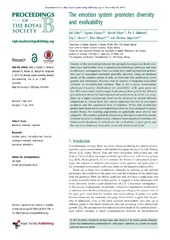The emotion system promotes diversity and evolvability
Giske, Jarl; Eliassen, Sigrunn; Fiksen, Øyvind; Jakobsen, Per Johan; Aksnes, Dag Lorents; Mangel, Marc; Jørgensen, Christian
Peer reviewed, Journal article
Published version
Permanent lenke
http://hdl.handle.net/1956/9032Utgivelsesdato
2014-08-06Metadata
Vis full innførselSamlinger
Originalversjon
https://doi.org/10.1098/rspb.2014.1096Sammendrag
Studies on the relationship between the optimal phenotype and its environment have had limited focus on genotype-to-phenotype pathways and their evolutionary consequences. Here, we study how multi-layered trait architecture and its associated constraints prescribe diversity. Using an idealized model of the emotion system in fish, we find that trait architecture yields genetic and phenotypic diversity even in absence of frequency-dependent selection or environmental variation. That is, for a given environment, phenotype frequency distributions are predictable while gene pools are not. The conservation of phenotypic traits among these genetically different populations is due to the multi-layered trait architecture, in which one adaptation at a higher architectural level can be achieved by several different adaptations at a lower level. Our results emphasize the role of convergent evolution and the organismal level of selection. While trait architecture makes individuals more constrained than what has been assumed in optimization theory, the resulting populations are genetically more diverse and adaptable. The emotion system in animals may thus have evolved by natural selection because it simultaneously enhances three important functions, the behavioural robustness of individuals, the evolvability of gene pools and the rate of evolutionary innovation at several architectural levels.

